G0EYO breathes New Life into his Vintage Kenwood Collection
Nostalgia can be a funny old business
In 1963 as a 16 year old I went to Bletchley Park to learn how to become a Government Radio Operator. I had to learn to receive morse code at up to 25wpm and to touch type. I was never taught to send CW. In 1986 I was able to pass the old 12wpm morse test to get my G0 call. In each passing year I made a New Year’s Resolution to become a proficient CW operator. I never got there. Sending morse from a prepared text was not the problem although it never took long before my wrist got stiff and I fell off the key.
Although I love the new digital forms of communication our hobby has given us, I believe CW is the purest method of communication and it has been an annoyance that I never gained the confidence to master sending it. I wish I was blessed with John, M6KET’s dedication to pursue this mode to the exclusion of all others. I have also long admired the proficiency that other friends such as Dale G3XBY and Lee G0MTN showed as CW operators, especially mastering Iambic keying which is supposed to be the most efficient way of sending morse. I never fancied using machine generated morse (MGM), although I believe it is very popular with contesters and DXers. I guess the key to sending CW in a QSO is the ability to think about your reply and actually send it at the same time without reading it from a text.
Strangely enough it was the sad passing of Roy G0HDF last year that triggered a series of events which have resulted in me deciding to make a real effort to become a proficient CW operator. In Roy’s SK sale was a Kenwood AT230 manual Antenna Tuning Unit. In 2014 I had purchased the Kenwood TS530 previously owned by club member Walter Chance M0GRO (sadly also SK). This got put away in a cupboard and came with me when we moved from Hollywood to Redditch in 2016. Seeing the two units together I realised what a thing of beauty this radio was, so set about looking for the matching Kenwood speaker SP230, which I eventually found on E-Bay.
From Roy’s SK sale I also purchased a Japanese Ameko K-4 telegraph key.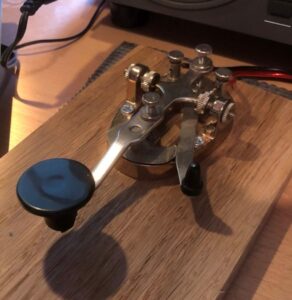 Practising with this key I found I preferred its feel to my Hi-Mound HK702 key. Perhaps I now had the right gear to do something about my long held ambition. Being of an older generation I have a real empathy with real knobs and switches, touch screens and the endless menu options of modern rigs has just never appealed to me. Fat arthritic fingers have never been best tools to use on touch screens.
Practising with this key I found I preferred its feel to my Hi-Mound HK702 key. Perhaps I now had the right gear to do something about my long held ambition. Being of an older generation I have a real empathy with real knobs and switches, touch screens and the endless menu options of modern rigs has just never appealed to me. Fat arthritic fingers have never been best tools to use on touch screens.
My usual HF rig is the Yaesu FT847 working into an SGC230 Auto ATU and long wire. This is exclusively devoted to FT8 using Ham Radio Deluxe, WSJT and JTAlert. I have to thank Roger M0GWM for putting up the antenna and running the feeder and control cables in and Ian M0LQY for setting up the FT8 software, a couple of years ago. The Kenwood vintage line-up looked as if it would fit on my office desk with the computer screens on a shelf above.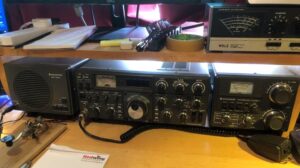 Having only one antenna and no wish to erect a second one, the problem to be solved now was how to connect a second radio up to it. At first I looked for a coaxial transfer switch as shown in the schematic below. As the switch is turned through 90 degrees , Tx 1 port is disconnected from the antenna port and connected to a dummy load port. At the same time Tx 2 port is disconnected from the dummy load port and connected to the antenna port: foolproof and ensures each transmitter is connected to an antenna or a dummy load, thus avoiding transmitting into an open circuit. Such transfer switches are common in commercial broadcasting or communication systems but are very expensive, so that wasn’t an option.
Having only one antenna and no wish to erect a second one, the problem to be solved now was how to connect a second radio up to it. At first I looked for a coaxial transfer switch as shown in the schematic below. As the switch is turned through 90 degrees , Tx 1 port is disconnected from the antenna port and connected to a dummy load port. At the same time Tx 2 port is disconnected from the dummy load port and connected to the antenna port: foolproof and ensures each transmitter is connected to an antenna or a dummy load, thus avoiding transmitting into an open circuit. Such transfer switches are common in commercial broadcasting or communication systems but are very expensive, so that wasn’t an option.
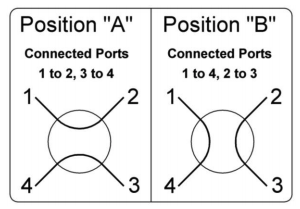
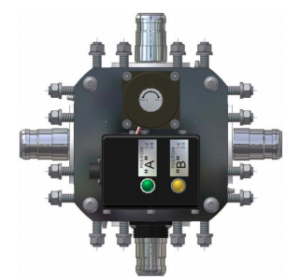 Looking through my junk boxes I found a couple of coaxial switches which might provide a cheap solution. One was a 4 way coaxial switch and the other a three way coaxial switch (see PHOTO below)
Looking through my junk boxes I found a couple of coaxial switches which might provide a cheap solution. One was a 4 way coaxial switch and the other a three way coaxial switch (see PHOTO below)
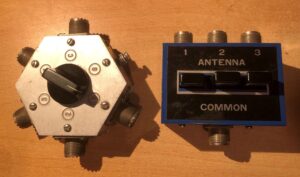
I used the 3 way switch to route the output of the FT847 set up to either the 4 way switch or the 100W dummy load. This would enable me to connect the output of the FT847 (via the Nissei Digital Power Meter) to a dummy load when using the TS530 set up. Not fail safe but an acceptable manual solution. The 4 way switch routed the output from the TS530 rig via a Welz Power/SWR meter to the feeder supplying the SGC230 External Auto ATU and Long Wire antenna. The Kenwood AT230 ATU has a dummy load switch position. When not connected to the antenna I can feed the TS530 output to a 500W dummy load under the desk.
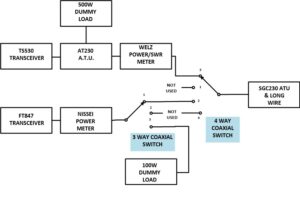
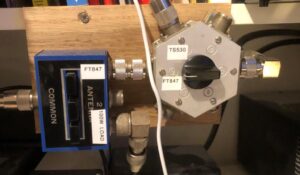
The TS530 transceiver is a hybrid with transistorised receiver and drive amplifier working into a tube based power amplifier. There are two power switches; one for Mains On and the other switches on the Heaters to the PA valves. By leaving the Heaters OFF, the set is in Receive Mode but I can key the internal oscillator to practise my CW and adjust the VOX Delay and Gain control to allow the break-in to work to my keying speed.
I will persevere but I now need to practise regularly and take up the kind offer of Chris G3YHF and John M6KET to be a friendly “fist” at the other end of a real QSO. Hopefully I will learn to operate the key and think at the same time without having to read a script. Let’s see how competent I am this time next year. Might even have a go at the Lew Williams CW Trophy!
Chris G0EYO

